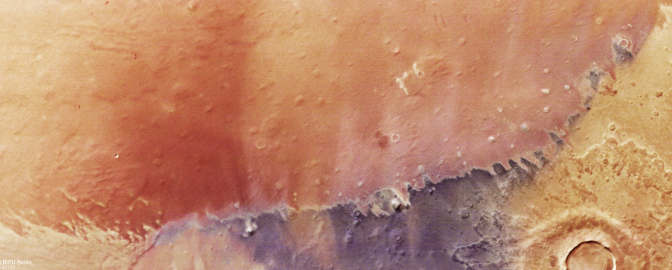Five asteroid deflection techniques to save the Earth

Written by
Jason Davis
May 23, 2023
Our corner of space is strewn with space rocks left over from the birth of the Solar System. These near-Earth objects, or NEOs, have orbits that bring them close to Earth’s orbit. Although they are scientifically interesting and can teach us about our origins, they can also be dangerous. A direct hit from a large object over a populated area could cause massive destruction and numerous casualties.
Fortunately, given enough time and preparation, it is possible to defend our planet from dangerous asteroids. Small nudges to a near-Earth asteroid’s path can have big long-term consequences, turning a direct hit into a near-miss.
A myriad of asteroid deflection methods have been proposed over the years. The technique we choose depends on how much time we have to prepare, the composition of the asteroid, and which technologies have been tested and shown to be the most reliable.
Here’s an overview of five asteroid deflection techniques and how they could save our planet.
Kinetic impactor
The principle behind the kinetic impactor technique is simple: Slam an object like a spacecraft into an asteroid, changing its trajectory.
The kinetic impactor is the only planetary defense technique that has been tested on an actual asteroid. DART, NASA’s Double Asteroid Redirection Test, was intentionally crashed into the asteroid moon Dimorphos in 2022. This altered Dimorphos’ orbit around parent asteroid Didymos by 33 minutes. A CubeSat deployed before impact, as well as the Hubble Space Telescope, JWST, and even ground-based telescopes, observed material streaming from Dimorphos into space. The push on Dimorphos from this escaping rubble was stronger than the push from the DART impact itself — an important finding from the mission.

DART also validated that it’s possible to send a spacecraft millions of kilometers to intercept an asteroid less than a kilometer wide, without any help from humans in the final moments. Traveling at the speed of light, signals from Earth took 38 minutes to reach the spacecraft as it closed on Dimorphos. DART autonomously took pictures of its target and made steering adjustments, demonstrating a key planetary defense capability.
Gravity tractor
A gravity tractor is a spacecraft that would fly alongside an asteroid, using its own gravity to tug on the asteroid and slowly change its trajectory. The mass difference between an asteroid and a spacecraft is huge; however, given months or years of lead time, small changes to an asteroid’s path would be possible, making the difference between an asteroid hitting or missing our planet.
The gravity tractor method offers the greatest control, allowing us to carefully direct an asteroid away from Earth. The downside is that this technique might not work on asteroids bigger than 500 meters (1,640 feet) in diameter.
Laser ablation
Zapping asteroids with lasers may bring to mind the classic Atari Asteroids game. But rather than shattering an asteroid into pixels, the laser ablation technique envisions one or more spacecraft focusing lasers on the surface of an asteroid, vaporizing rock and creating small ejecta plumes. These plumes push on the asteroid, slowly changing its course.
The Planetary Society funded testing of a laser ablation concept called Laser Bees. Laboratory tests of the technology allowed scientists to update theoretical models, and showed that it could be a feasible asteroid deflection technique.
A variation of the laser ablation technique is solar ablation. Rather than using lasers to vaporize rocks, a spacecraft would use mirrors to direct sunlight onto an asteroid’s surface.

Ion beam shepherd
What if you could push an asteroid with your spacecraft’s thruster? That’s the concept behind the ion beam shepard, which relies on an ion engine’s exhaust to impart force on an asteroid.
Space missions have been using ion propulsion for decades, from Deep Space 1 to Dawn to DART. An ion engine electrically charges a fuel like Xenon, creating ions that are accelerated out of the spacecraft at very high speeds. Ion engines are not as high-thrust as conventional spacecraft engines, but they can operate continuously over long periods of time, eventually pushing a spacecraft to higher velocities.
What if a spacecraft aims its ion engine at an asteroid? The accelerated ions would hit the asteroid, giving it a gentle push. It might take months or years for this method to nudge an asteroid off course from Earth, so plenty of warning time would be required. The spacecraft would also need a secondary propulsion system to fire in the opposite direction, since the ion engine would also push the spacecraft away from the asteroid.
One paper studying the concept says that the ion beam shepherd technique is more efficient than a gravity tractor for asteroids under 2 kilometers (1.2 miles) wide.
Nuclear blast
What if our efforts to deflect an Earth-bound asteroid failed, or we didn’t see an asteroid coming until it was too late? A last-resort option could be a nuclear blast. This technique would fire a nuke-laden spacecraft at an asteroid in an attempt to deflect it away from Earth.
In addition to the dangers inherent to launching a nuclear weapon into space, the asteroid could shatter into multiple large pieces, turning one devastating asteroid impact into multiple devastating impacts. Nevertheless, it could be our best option in a planetary emergency. A recent study shows that a nuke detonated next to an asteroid 100 meters (328 feet) wide, at least two months before impact, could blast 99.9% of the asteroid’s mass out of Earth’s way.
Supporting deflection techniques
The best way to support any asteroid deflection technique is to find asteroids long before they find us. NASA’s upcoming NEO Surveyor mission will help in this regard, pinpointing 90% of near-Earth objects with diameters of at least 140 meters (460 feet) within 10 years.
We often need to observe newly discovered NEOs multiple times to determine their orbits. The Planetary Society supports this and other planetary defense efforts through our Shoemaker NEO grant program. Our grant winners are part of a worldwide group of astronomers who find, track, and characterize asteroids to help protect our planet.
Additionally, the European Space Agency’s Hera mission will launch in 2024 to visit asteroid Dimorphos and survey the aftermath of the DART impact. Continued research, technology development, and space missions will help protect us from the Solar System’s smallest denizens.
Support our core enterprises
Your gift today will go far to help us close out the year strong and keep up our momentum in 2026.
Donate

 Explore Worlds
Explore Worlds Find Life
Find Life Defend Earth
Defend Earth

